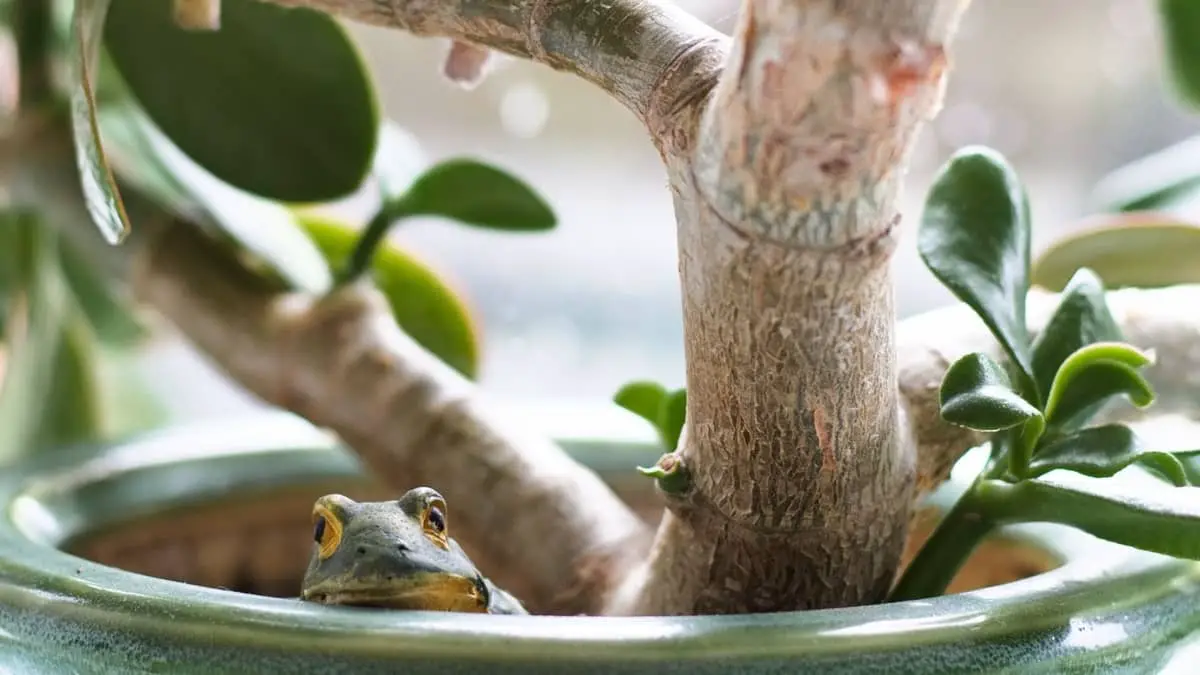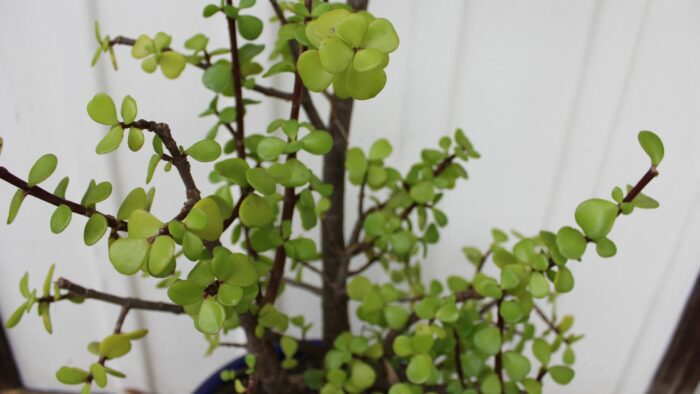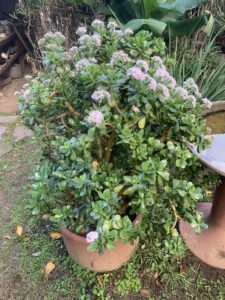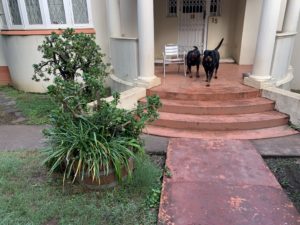Last Updated on February 20, 2023 by Griselda M.
This blog post tells you how to fix a jade plant broken trunk and more. The jade plant, or Crassula ovata, is a beautiful plant that is incredibly tough. These things have to deal with elephants, rhinos, and baboons in the wild. They are adapted to survive abuse, and knowing how to tend to your jade plant is important. This plant thrives on neglect. If you have a Jade plant with a broken trunk, I will explain how to turn this into an advantage!
Causes of the Jade Plant Stem Breaking
There are many causes of the jade plant stem breaking. A jade plant broken trunk can become somewhat of a hassle if not attended to promptly. Therefore, knowing how to fix a jade plant’s broken trunk is essential to keep it thriving. However, the most notable ones are underwatering or overwatering your jade plant, soil that has poor drainage capabilities, and the excessive use of fertilizers, amongst others. Other reasons include the plant being top-heavy, too much or too little sunlight, and extreme temperature changes that can cause it to fall over and break.
If you find that your jade plant leaves are mushy or soft, this could be because these plant leaves are known for holding onto too much water. Pest and diseases are drawn to jade plants that have mushy leaves and should be dealt with immediately to avoid further deterioration. However, in most cases, broken branches usually take root, which results in new jade plants that grow quite rapidly.
Rooting Large Jade Cutting
Aside from knowing how to fix a jade plant broken trunk, rooting large jade cutting is simple and easy if you have the right steps to follow. The easy steps below will aid you in propagating your jade plant cutting in water without any hassles. Keep in mind that the following method can be used to root any jade plant if properly implemented.
Jade Plant Rooting Steps:
1. Cutting
To cut off a healthy jade plant stem for rooting purposes, it is advisable to use garden pruners or a sharp knife that has been sterilized. Make sure to remove the leaves at the bottom of your jade plant cutting to allow for easy submerging in water.
2. Allow for Callousing
After you have retrieved your large jade plant cutting, you must allow it to callous over before placing it in the water vessel. Callousing is the act of allowing your cutting to air dry over a few days to eventually form a scab. The scab will protect the cutting when it is submerged in water and avoid rot.
3. Rooting
After your jade plant cutting has calloused, you should have your water vessel ready. You can now put your cutting in water to allow for rooting. Keep in mind that the base of the cutting from where leaves were initially removed should be submerged in water. Any leaves that are at the top of the cutting should be above the water line.
4. Location
It is highly recommended that you place your submerged plant in a bright location for the best results. A windowsill that receives shaded light would be ideal in this instance. If all is well, the roots should be visible in a few weeks. Remember to change the liquid in the vessel with fresh water at least twice a week. Remember to look out for a jade plant broken trunk and fix it before it worsens.
How to Grow a Jade Plant into a Tree
It is quite beneficial to learn how to grow a jade plant into a tree, especially if that is your aim. These succulents have thick trunks which make them stand out, whether you choose to plant them indoors or in an outdoor garden. Although it is very simple to grow a jade plant into a tree, it takes careful care and maintenance, timeous pruning, feeding, training, and a lot of patience to aid them in reaching their full potential.
Here are a few useful tips to grow your jade plant into a beautiful tree:
Plant Pot
Pick the right-sized plant pot or outdoor spot to grow your jade tree. A pot that is about 8 to 14 inches would be ideal for an established plant to develop into a tree. Measure the root ball when choosing the planter, as it should be a size larger than the root ball. If you opt for an oversized pot at the beginning, you may cause waterlogging, which can flaw your plant roots.
Trunk Training
Training the trunk of your jade plant is essential if you want it to grow into a tree. This training should include getting rid of any side stems and only keeping the main one that will eventually serve as the tree trunk. Additionally, any other foliage and branches that threaten to flaw the growth of the main stem should also be removed. To give the plant a top-heavy look that resembles a tree or bonsai, pruning the jade plant on the lower half is best.
Sunlight
An efficient amount of direct and indirect sunlight is essential for the health and growth of a jade plant. This helps the plant to grow its best and develop into a tree. To make the tree grow strong and tall, allowing it an equal amount of light by rotating the planter would be beneficial in its development. Also, ensure that sunlight exposure is received from the top as the plant grows towards the heat source and enhances in length. If sunlight is received from the sides of the jade plant, then it will increase in with rather than length.
Fertilizer
It is best to fertilize your jade plant tree every two to four weeks. This should be done during the growing season using a balanced liquid fertilizer. Diluting it to a quarter of the recommended strength is advised, as the jade plant will grow more quickly with active feeding. You can watch as your plant develops into a sturdy jade tree.
How to Make a Jade Plant Thicker
The following information is for those who want to know how to make a jade plant thicker. Although there are more than 300 varieties of this evergreen succulent, the tips below can be used on any one of them to thicken the plant.
Tips:
- – Pruning jade plants above their leaf scar, which is a brown ring located around the stem, will allow them to grow back thicker. Keep in mind that you have control of which part of the plant you want to grow thicker, so target that area. This method can also be used on jade plants that have become leggy.
- – Pinching the stem ends to remove the growing tips is also great for your jade plant to have a fuller look. This is because new growth will appear from the picked sites that will develop into thicker trees. Young jade plants usually do pretty well with this method.
- – Jade plants flourish in daytime temperatures between 65-75 F and night temperatures of about 50-55 F. Also, to achieve a fuller-looking plant, at least four hours of full sun daily is recommended. Ensure that your plant is not exposed to drafts, as this will flaw its growth.
- – Jade plants need soil that is well draining to grow their best. For this reason, using a plant container with drainage holes is necessary. It is not necessary to repot your jade plant often as it will slow down its growth.
- – In the spring and summer months, watering your jade plant often is recommended to maintain soil moisture. This does not mean that the soil should be overly wet. During the winter season, you should allow the soil to dry out completely before rewatering. The plant leaves should never be directly watered, as only the soil should be fed. This will allow the plant to naturally produce thicker foliage.
- – Fertilizer is an important part of jade plant maintenance as it aids in keeping the plant fuller. Water-soluble fertilizers are best in this case and should be used quarterly for a thick, lush jade plant.
What is a Jade Plant?
This is a small to medium size succulent plant from Southern Africa. I have seen them attain 7 feet in height in the wild, but in gardens, they normally attain a lower height in our lifetimes. These plants are relatively fast-growing plants, but when they get to a specific height they slow down.
Scientifically, the Latin name for the Jade plant is Crassula ovata. These plants grow in a vegetation type known as a sub-tropical thicket. This ecosystem is drought-adapted and these plants have a CAM photosynthetic cycle. If you understand this, and how it works, you will then find it easy to care for your plant.
What is CAM Photosynthesis?
Crassulacean acid metabolism photosynthesis is a rather crafty adaptation some succulent plants use to survive in very harsh environments. Normal non-CAM plants absorb sunlight – which drives photosynthesis – using solar energy to convert carbon dioxide and water into glucose the energy molecule. To photosynthesize, plants need to have their stomatal pores open so that carbon dioxide from the atmosphere can diffuse into the leaves. Oxygen produced then exits these stomata and floats around where it can be used for useful things such as our breathing (or foolishly burnt in vehicles).
The problem with having pores open during the day is that if it is hot and dry, a lot of water gets lost in the atmosphere. What if a plant could photosynthesize at night you say? Well, there is no sunlight….. But wait – CAM plants are crafty – they store energy captured from the sun in Crassulacean acid, and then use this energy at night to drive the photosynthetic cycles. This is rather clever actually because the plants can open their stomatal pores and then not worry about losing water to the atmosphere. What is even cleverer, is that the CAM process absorbs heat – so the plant leaves get cold – and cold leaves attract moisture – the CAM plants literally create their own rain.
Yep, even the name of that cycle has something to do with our Jade plant, Crassula ovata.
Understanding Elephant and Jade Plants
In its natural habitat, the Jade plant spreads by being eaten by elephants. These huge animals grab a trunk and snap it off and wave it through the air and shove it into their mouths. They are messy eaters! Little pieces break off and fall in the bushes below the elephant, and many of these will root and become new plants!
The jade plant has actually evolved to be easy to break – this helps it disperse and spread. Hence it is quite natural that branches will break off your plant from time to time. Cats, kids, vacuum cleaners, feather dusters, and so on are all quite capable of breaking a branch or two off the plant. Hence a Jade plant with a broken trunk is a normal sort of occurrence and part of the plant’s lifecycle.
In nature, megaherbivores such as elephants break and spread jade plant pieces in the thicket. These cuttings sometimes root and create new plants. In the urban environment pets and kids and similar destructive influences break the plants. You can see the plant in the barrel pot in front has been heavily damaged in a Rottweiler incident. My parents have grown many plants from cuttings detached from plants in such incidents.
How to Grow a Jade Plant From a Cutting
I normally leave a broken branch on a windowsill for a week. This helps the break harden off. It will turn into a white callus. Maybe two weeks. Don’t worry – you cannot kill these plants. Once the plant is ready, put it in a pot. If you want to be fancy use specially formulated succulent soil. You can basically grow this plant in rocks if you want to! I have seen them growing in shale with no soil at all. This plant is tough. But it grows faster in good soil.
The cutting will root in a few months and the plant will start growing. Do not water it very much – make the soil damp once a week, or even less.
Tricks to Make The Plant Happy
These plants need some Sunlight. And they do not like being overwatered. Remember they have CAM photosynthesis, so they enjoy being able to get a little cold at night. They are moderately frost tolerant in the wild. People make the mistake of not letting them have warm days and cool nights. If you give them enough light, and some temperature fluctuations the plants build up strong leaves and are very disease resistant.
If the leaves get cool at night, the plant can store sugar in its leaves because its metabolic rate slows down. When this happens, it becomes less attractive to its most common pest, the mealybug.
If you keep them warm day and night they just don’t do as well because they run low on sugar in their leaves due to rapid metabolism at night. This then means they go through the next day storing CAM, and run low on sugar the next night making the plant weak and sad, and disease-prone.
I find that my plants enjoy being hosed down every month. Take the pots outside and spray the leaves down with a fine hose spray this doubles as a nice deep watering. Let the plant dry out in the pot for two weeks and water again. Lightly. This regular watering removes the salty layer that sometimes appears on the leaves and this makes the plants glow a lovely green color in the sunlight.
FAQs
How do you save a broken jade plant?
Jade plants break often in their natural environment. Elephants and rhinos break them, and pieces fall of and grow into new plants. You can do the same. If your plant loses a branch, plant it and it will become a new plant.
How do you grow a jade plant from a broken stem?
Take the broken stem and let it dry out on the broken end for a week or two. Insert the stem as deep as possible into soil - 6-7 inches in potting soil and it will root. These plants are very robust and root easily.
Can you cut the main trunk of a jade plant?
Yes you can. After you cut it, let the piece you cut off dry off on the cut wound for a week or two and then plant it. It will grow into a new plant. With time these things can become a forest.
Why did my jade plant break?
Jade plants are naturally fragile and shed branches. This is how they spread in nature - an elephant or rhino breaks off a branch and little pieces fall on the ground and grow. So these plants break very easily. Do not worry. Just plant the piece that broke. You will get another free plant!
Dr. Garth A. Cambray is a Canadian/South African entrepreneur and beekeeper with 28 years of experience in apiculture and specializes in adding value to honey. His Ph.D. research developed a new advanced continuous fermentation method for making mead that has resulted in a number of companies globally being able to access markets for mead. His company, Makana Meadery, exports honey mead to the USA where it is available to discerning connoisseurs. He has also developed technologies to commercially manufacture organic honey vinegar in Zambia for export globally. He holds a few patents globally in the ethanol industry and believes in technology and knowledge transfer for human development and environmental sustainability. One of his proudest achievements is the fact that the wind farm he started at one of his old apiary sites has essentially made his hometown carbon neutral.





